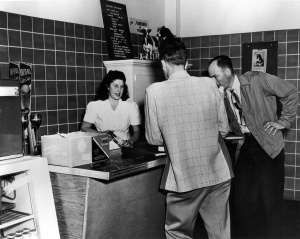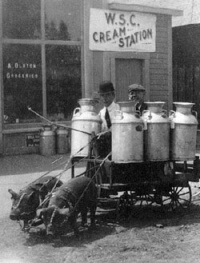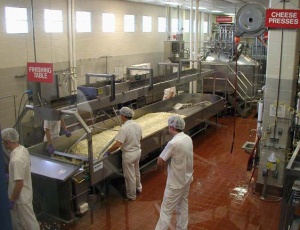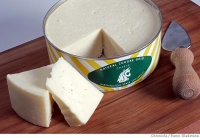Personal tools
Help
Tools
Class Notes
- Do you have news for fellow WSU alumni and other readers of Washington State Magazine? Send us your class note.
Our Story
written by alumni, faculty and friends.
NOTE: THIS IS A LEGACY SITE AND IS NOT REGULARLY MAINTAINED
Views
Difference between revisions of "Ferdinand's turns 60"
From Our Story
m |
|||
| (2 intermediate revisions by the same user not shown) | |||
| Line 1: | Line 1: | ||
| − | [[Image:Daniel Koh.jpg|thumb|left]] | + | [[Image:Daniel Koh.jpg|thumb|left]] |
From ''Washington State Magazine'', Winter 2008/09 | From ''Washington State Magazine'', Winter 2008/09 | ||
| − | + | <br> | |
By Dennis Brown | By Dennis Brown | ||
| − | | + | |
| + | <br> | ||
| − | + | This brief item appeared on the front page of the ''Daily Evergreen ''on Monday, October 11, 1948: | |
| − | This brief item appeared on the front page of the Daily Evergreen on Monday, October 11, 1948: | ||
<blockquote>''Dairy Dept. to Open Counter in Troy Hall''</blockquote><blockquote>''The department of dairy husbandry will start operating a dairy counter serving ice cream, plain and chocolate milk on the first floor of Troy hall near the north entrance.''</blockquote><blockquote> | <blockquote>''Dairy Dept. to Open Counter in Troy Hall''</blockquote><blockquote>''The department of dairy husbandry will start operating a dairy counter serving ice cream, plain and chocolate milk on the first floor of Troy hall near the north entrance.''</blockquote><blockquote> | ||
| − | ''Assistant professor L. J. Manus will be in charge, assisted by dairy manufacturing students. All products served will be made in the department, and prices will be comparable to those charged downtown.'' | + | ''Assistant professor L. J. Manus will be in charge, assisted by dairy manufacturing students. All products served will be made in the department, and prices will be comparable to those charged downtown.'' |
</blockquote><blockquote> | </blockquote><blockquote> | ||
| − | ''Later on, when obsolete equipment has been replaced, milkshakes, cheese and possibly other dairy products will be sold. An open house is planned for sometime in November when the plant is complete. Such ventures have been very successful at other schools, it was reported.'' | + | ''Later on, when obsolete equipment has been replaced, milkshakes, cheese and possibly other dairy products will be sold. An open house is planned for sometime in November when the plant is complete. Such ventures have been very successful at other schools, it was reported.'' |
| − | </blockquote> | + | </blockquote> |
[[Image:Ferds-old-counter.jpg|thumb|right|300px]]The dairy counter, which did not acquire its Ferdinand’s appellation until a year later, actually opened on September 24. It was the byproduct of a decision by Washington State College to take over management of the Troy Hall Creamery, which had been operated by Milk House, a private dairy company, since 1926.The contractor had processed milk from the college’s dairy herd and supplied milk products to college dining halls. Milk House also sold some dairy products at a retail outlet in downtown Pullman. | [[Image:Ferds-old-counter.jpg|thumb|right|300px]]The dairy counter, which did not acquire its Ferdinand’s appellation until a year later, actually opened on September 24. It was the byproduct of a decision by Washington State College to take over management of the Troy Hall Creamery, which had been operated by Milk House, a private dairy company, since 1926.The contractor had processed milk from the college’s dairy herd and supplied milk products to college dining halls. Milk House also sold some dairy products at a retail outlet in downtown Pullman. | ||
| Line 33: | Line 33: | ||
Carbon dioxide was the main obstacle that Golding had to overcome. Cheese develops carbon dioxide as it ages, causing cans to bulge. Golding developed a cheese using adjunct cultures that eliminate gas production. The cheddar-like cheese was named for him and WSC’S mascot. | Carbon dioxide was the main obstacle that Golding had to overcome. Cheese develops carbon dioxide as it ages, causing cans to bulge. Golding developed a cheese using adjunct cultures that eliminate gas production. The cheddar-like cheese was named for him and WSC’S mascot. | ||
| − | Cougar Gold and Cougar Cheddar were the first cheeses offered by the Creamery. During the 1950s and 1960s, raw milk versions of Cougar Gold (called Bam) and Cougar Cheddar (called Ram) also were available. “They had a slightly different flavor, but they weren’t flavored cheeses,” said Marc Bates ’70 ’76, who began working in the Creamery as a student in the 1960s and managed the facility from 1974 to 2000. [[Image: | + | Cougar Gold and Cougar Cheddar were the first cheeses offered by the Creamery. During the 1950s and 1960s, raw milk versions of Cougar Gold (called Bam) and Cougar Cheddar (called Ram) also were available. “They had a slightly different flavor, but they weren’t flavored cheeses,” said Marc Bates ’70 ’76, who began working in the Creamery as a student in the 1960s and managed the facility from 1974 to 2000. [[Image:Making cheese.jpg|thumb|right|300px]] |
“As far as I know, Caraway was the first cheese that had a flavor compound added to the cheese,” he said. “It was there in the 1960s. I don’t know when it was first done.” | “As far as I know, Caraway was the first cheese that had a flavor compound added to the cheese,” he said. “It was there in the 1960s. I don’t know when it was first done.” | ||
| Line 47: | Line 47: | ||
New equipment, elimination of less popular cheeses, and the new storage facility has made it possible for the Creamery to overcome a long-standing problem--not having enough Cougar Gold on hand to meet heavy demand during the holiday season. | New equipment, elimination of less popular cheeses, and the new storage facility has made it possible for the Creamery to overcome a long-standing problem--not having enough Cougar Gold on hand to meet heavy demand during the holiday season. | ||
| − | “We haven’t run out of Cougar Gold the past two years,” Salvadalena says.<br> | + | “We haven’t run out of Cougar Gold the past two years,” Salvadalena says.<br> |
---- | ---- | ||
| − | A longer version of this story first appeared in ''Connections'', the magazine of the College of Agricultural, Human, and Natural Resource Sciences. | + | A longer version of this story first appeared in ''Connections'', the magazine of the College of Agricultural, Human, and Natural Resource Sciences. |
| + | |||
| + | [[Category:Creamery]] | ||
Latest revision as of 17:05, February 20, 2009
From Washington State Magazine, Winter 2008/09
By Dennis Brown
This brief item appeared on the front page of the Daily Evergreen on Monday, October 11, 1948:
Dairy Dept. to Open Counter in Troy Hall
The department of dairy husbandry will start operating a dairy counter serving ice cream, plain and chocolate milk on the first floor of Troy hall near the north entrance.
Assistant professor L. J. Manus will be in charge, assisted by dairy manufacturing students. All products served will be made in the department, and prices will be comparable to those charged downtown.
The dairy counter, which did not acquire its Ferdinand’s appellation until a year later, actually opened on September 24. It was the byproduct of a decision by Washington State College to take over management of the Troy Hall Creamery, which had been operated by Milk House, a private dairy company, since 1926.The contractor had processed milk from the college’s dairy herd and supplied milk products to college dining halls. Milk House also sold some dairy products at a retail outlet in downtown Pullman.Later on, when obsolete equipment has been replaced, milkshakes, cheese and possibly other dairy products will be sold. An open house is planned for sometime in November when the plant is complete. Such ventures have been very successful at other schools, it was reported.
Ferdinand’s became the campus retail outlet for the WSC-managed creamery. In the beginning, Ferdinand’s offered milk and three flavors of ice cream. It is not clear if cheese was on the menu. The first week, Ferdinand’s took in a total of $9.42, according to the receipts.
From those humble beginnings, the Creamery and Ferdinand’s have flourished. Last year the self-sustaining operation generated about $4.5 million in sales of cheese, ice cream, and coffee, according to Russ Salvadalena ’77, Creamery manager since 2000.Income generated by sales pays the salaries of 11 full-time employees and about three dozen part-time student workers, and supports one faculty member position and two or more graduate students in WSU’s food science department.
“Our mission,” says Salvadalena, “is to provide teaching and research opportunities to the university and the dairy industry, an exceptional work experience to student employees, and financial support to students and the university.”
Cougar Gold accounts for almost 80 percent of cheese sales. The sharp, white cheddar cheese was developed in the 1930s and 1940s by WSU dairy scientist Norman S. Golding while conducting research aimed at creating natural cheeses that could be vacuum canned.
At the time, vacuum canning was viewed as a potentially good method for storing, aging, and transporting cheese. Plastic packaging materials had not been invented, and wax packaging sometimes cracked, leading to contamination.
Carbon dioxide was the main obstacle that Golding had to overcome. Cheese develops carbon dioxide as it ages, causing cans to bulge. Golding developed a cheese using adjunct cultures that eliminate gas production. The cheddar-like cheese was named for him and WSC’S mascot.
Cougar Gold and Cougar Cheddar were the first cheeses offered by the Creamery. During the 1950s and 1960s, raw milk versions of Cougar Gold (called Bam) and Cougar Cheddar (called Ram) also were available. “They had a slightly different flavor, but they weren’t flavored cheeses,” said Marc Bates ’70 ’76, who began working in the Creamery as a student in the 1960s and managed the facility from 1974 to 2000.“As far as I know, Caraway was the first cheese that had a flavor compound added to the cheese,” he said. “It was there in the 1960s. I don’t know when it was first done.”
Viking, a mild-flavored, semi-soft cheese, was introduced in the early 1970s. It was created by Joe Muller ’70 and Paul Nelson ’70, two of Bates’ classmates in food fermentation class.
While Cougar cheeses are sold in 30-oz. cans now, at various times during the 60-year history of Ferdinand’s they have been packed in 40-ounce, 4-pound, and 41/2-pound tins, depending on the availability of cans.
“The Creamery doesn’t use a lot of cans, so the managers have had to look for cans they could easily adapt,” says Bates. “You can change the height of the can without any major capital expense, but not the diameter. That’s why we have been hung up all these years with a 6-inch diameter can because the whole facility would have to be re-tooled to change the diameter.”The Creamery and Ferdinand’s moved from Troy Hall to its present location in the Food Quality Building, north of Clark Hall, in 1992.
The plant size doubled to 15,600 square feet, adding production capability. The new facility offered seating for customers as well as a viewing room where visitors can watch cheese being made.
New equipment, elimination of less popular cheeses, and the new storage facility has made it possible for the Creamery to overcome a long-standing problem--not having enough Cougar Gold on hand to meet heavy demand during the holiday season.
“We haven’t run out of Cougar Gold the past two years,” Salvadalena says.
A longer version of this story first appeared in Connections, the magazine of the College of Agricultural, Human, and Natural Resource Sciences.
Our Story site map
Our Story main page | Our Story categories | Help Desk
Contact | Give | Advertise
Washington State Magazine | Washington State University | Class Notes
Our Story is coordinated by
In partnership with
Our Story and Washington State Magazine are publications of Washington State University. All rights reserved.
P.O. Box 641227, Washington State University, Pullman, WA 99164-1227 USA | wsm@wsu.edu, 509-335-2388
Accessibility | Copyright | Policies





